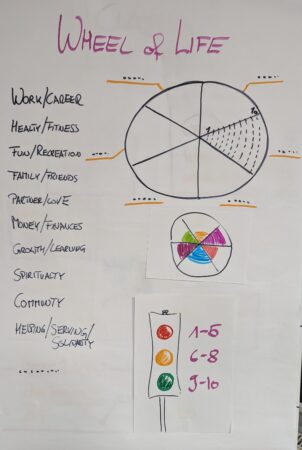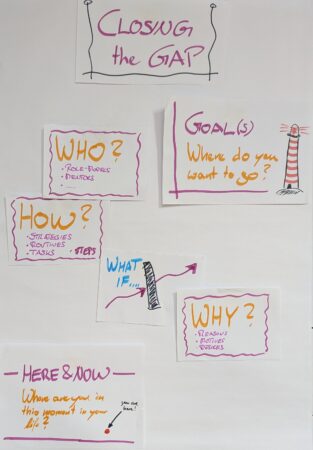How to plan ahead with your volunteer | Mentoring under Construction
![MuC MeetUP #1 [Andy Hu via unsplash]](https://michaelkimmig.eu/wp-content/uploads/2024/02/MuC-MeetUP-1-Andy-Hu-via-unsplash-800x450.jpg)
The content of this blog post has been created in the context of Mentoring under Construction. Mentoring under Construction is a community for mentoring practitioners within the European Solidarity Corps programme.
Goal setting and action planning – once volunteers have arrived and become more acquainted with their work, the organisation and the local environment, it is time to make plans: How to help volunteers to set goals and action steps towards them? How can you support them to overcome obstacles? How can you keep them accountable? What strategies and tools can you use for goal setting and action planning?
“If you don’t design your own life plan, chances are you’ll fall into someone else’s plan. And guess what they have planned for you? Not much.”
Jim Rohn
We all know that setting goals is important as we move through life. Goals can give us a direction in many areas of our life: work, finances, relationships, fitness, health, growth, etc. They help to align your focus and foster a sense of self-mastery.
The tricky thing with setting goals is often that we clarify where we want to go but we either don’t move towards our goal, give up as soon as we meet an obstacle or lose our drive to push through. In order to do goal setting and action planning right, you need a framework to touch on the most important aspects to make it work.
A framework for setting goals and planning actions (that you are actually going to follow through)
Five Steps to Close the GAP is a framework to work on setting goals and planning actions adapted from “Closing the Gap” by Dean Graniozi and Tony Robbins.
Step 1: Where are you now?
Before you clarify where to go, you need to know where you are right now.
Choose one area in your life, like work/career, relationships, health, growth, etc. that you want to improve. Rate it on a scale from 1 to 10, where 10 marks the best you can imagine and 1 is the opposite.
Which area(s) of your life need the most attention now?
If your score is 5 or less, that is definitely something you should work on, if it is between 6 and 8, there is space to improve. If it is 9 or 10, you are fine and you’d better choose another area of your life to work on.

An easy way to do this is the wheel of life. Here are two websites where you can do this test online: Wheel of Life Interactive Assessment (predefined categories) and Wheel of Life (customised categories).

Step 2: Where do you want to go?
When you identified the area(s) in your life you would like to improve, you need to define what exactly you want to reach/achieve in this area (these areas):
- What do you want for yourself in this area?
- What would you like to reach/achieve?
- What person would you like to grow into?
Step 3: What’s your why?
This is about exploring your desires (What do you really want for yourself?), reasons (Why do you want it?) and purpose (What drives you?). You can ask yourself:
- Why would this excite you?
- What would it mean to you?
- Why are you going to achieve it?
- How will it change the quality of your life and the people around you?
Step 4: How do you get there?
The “how” is about strategies, steps, routines and tasks that get you closer to your goals:
- What steps are you going to take towards your goal?
- What strategies will help you to get there?
- What routines will you build?
- What things will you learn?
Step 5: Who did this already? From whom could you learn?
The last step is about resources or a shortcut you could use. A person that has a blueprint for how to get to your goal, someone you can learn from, someone who can guide you there can save you a lot of time and effort. Instead of figuring everything out on your own, this person can show you a shortcut:
- Who has already achieved what you’re aiming at?
- Who is an expert / a role model / mentor in that field?
- From whom can you learn? Who could be your mentor?
Closing the GAP
HERE & NOW: Where are you now?
GOAL: Where do you want to go?
DRIVE: Why do you want to go there? (desire, reasons, purpose)
ACTIONS: How do you get there? (strategies, routines, tasks)
THE SHORTCUT: Who has the blueprint? (role model, mentor)
What if… About Pitfalls and Roadblocks
“When you set a goal, your brain opens up a task list.”
Mel Robbins
The first pitfall is not spending enough time exploring why you want something. You might jump immediately from your goal to action steps in order to move quickly forward. However, if you lose motivation or hit a roadblock, knowing your WHY will help you to push through difficult moments.
The recommendation here is: If you’re missing drive, you need to work on your why! Think of strong enough reasons. Purpose is always stronger than the goal. Don’t jump immediately to the HOW.
“A goal without drive, does not get you anywhere.”
Brendon Burchard
The second pitfall is that – instead of goals – you generate a list of tasks. Instead of a clear direction, you are ending up with a huge to-do list, which is not at all tempting to get it done. Remember: tasks are not goals. Tasks are something you do. Goals give you a direction, something you want to reach, achieve, etc.
Goals need to be a compelling vision of what you want. They need to excite you. If a goal does not resonate with you, does not lift you up, drop it.
“When the WHY gets stronger, the HOW gets easier.”
Jim Rohn
Finally, negative thinking patterns might get in your way and hold you back. Two of the most common ones are:
- “I don’t know how…” – If you don’t know how to get something done, that’s usually a great opportunity to learn something. Identify what you need to learn and make it your priority, so you can move towards your goal.
- “I don’t have…” is about resources, or rather ‘lack of resources’. Don’t let this become an excuse not to move forward. Hardly anyone has all the resources at hand when starting their journey. Be resourceful, find and build those resources. Learn from other people who were in a similar situation to yours.
Your turn…
Have a look at those five areas … here & now, goal, drive, actions, the shortcut.
- Which areas work best for you?
- What methods/tools do you have to work on those areas?
- Which pitfalls and roadblocks you need to pay attention to?
- What are your recommendations?
7 Things to keep in mind when you work with goals
- Have many goals – Make a whole list of goals
- Dream big – Don’t make goals too small, have (Life)Goals that stretch you
- Goals that stick – Write goals down and visualize them. Remember: Goals need to be exciting, compelling, motivating.
- Goals are not written in stone – Revisit them, throw out some of them, take new ones in, change and adjust them on the go
- Check on goals – Revisit your goals regularly, check if they are still relevant. Check your progress and how to proceed further
- Goals without action don’t lead you anywhere – Create massive action. Develop at least 2 action steps (one small one today, a bigger one next week)
- Actions need space – Make space for your actions. Put them in your calendar.
Recommended Resources
The Importance, Benefits, and Value of Goal Setting (2019) by Leslie Riopel,positivepsychology.com
What is Goal Setting and How to Do it Well (2019) y Elaine Houston, positivepsychology.com
The Science & Psychology Of Goal-Setting 101 (2019) by Madhuleena Roy Chowdhury, positivepsychology.com
Goals Toolkit: How to Set & Achieve Your Goals | Huberman Lab Podcast
The Goals Guide: Master Setting and Achieving Your Goals by J.D. Meier via gettingresults.com

Mentoring under Construction. Join our Community
The Mentoring under Construction Community is open for everyone who is interested in raising the quality in mentoring within European Solidarity Corps programme (and beyond): mentors, project managers/organisers, coordinators of volunteers, facilitators of learning, authors and trainers, and members of National Agencies and SALTO Resource Centres.
Mentoring under Construction | SALTO
Mentoring under Construction Community | Facebook



![MuC Mentoring Competence Framework [title slide]](https://michaelkimmig.eu/wp-content/uploads/2024/12/MuC-Framework-title-520x245.jpg)